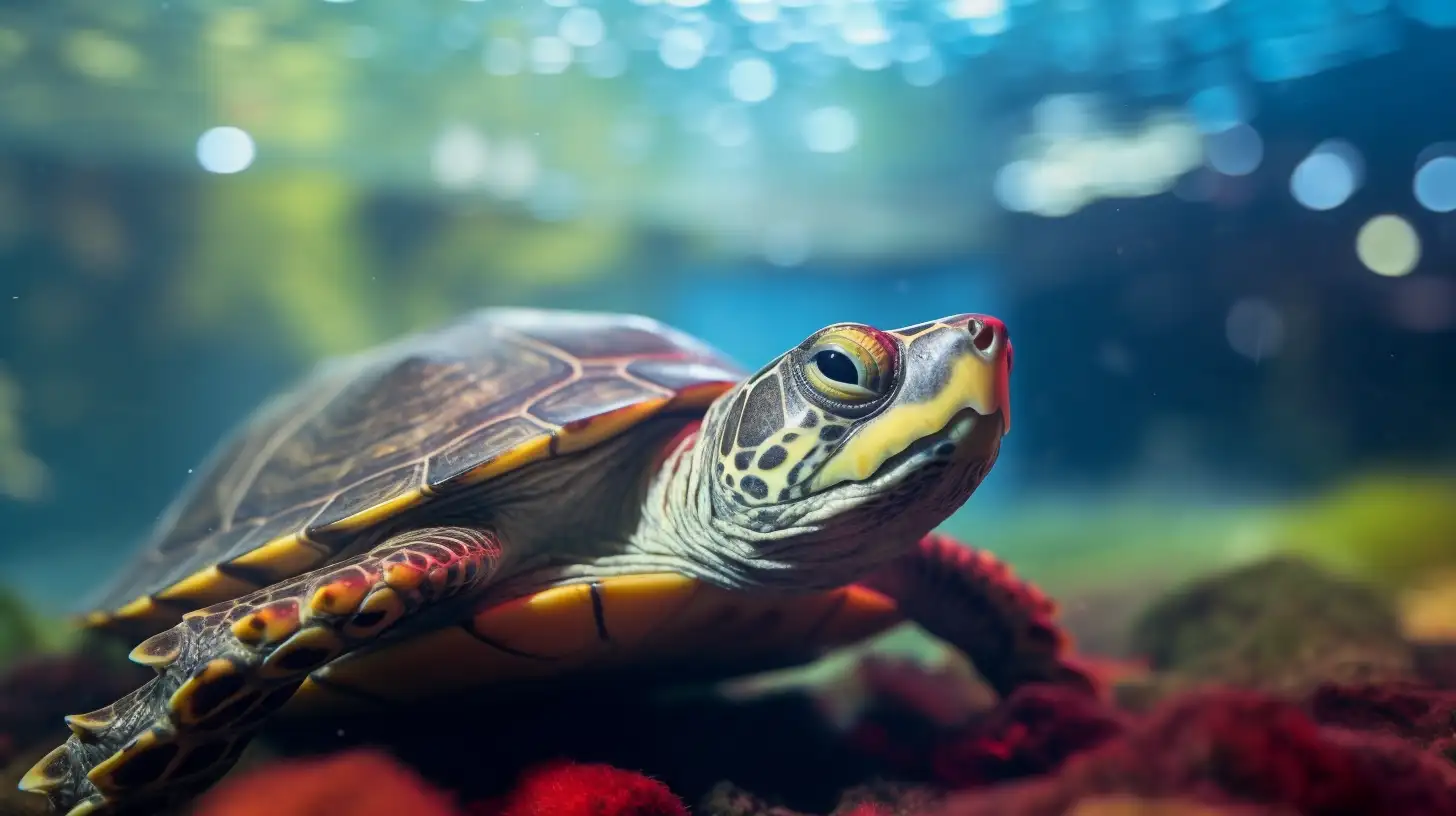Table of Contents
A terrapin can make for a fantastic starter pet, particularly for youngsters, as these creatures are easy to take care of and do not require too much space. They also live for a very long time. Those considering a terrapin as a pet will need to know what is required to take care of these wonderful creatures (in terms of housing, temperature, etc.). One especially important consideration is food. So, what do terrapins eat? You will need to know what type of food a terrapin enjoys eating, how often it should be fed, and how much food should actually be given. It is also worth knowing what to do if the terrapin stops eating.
What Do Terrapins Eat?
While generally omnivorous creatures, terrapins in the wild eat mostly live foods such as fish and insects, although they will eat some plants. In captivity, you have an opportunity to offer up a varied and balanced diet to ensure your pet thrives.
in the wild eat mostly live foods such as fish and insects, although they will eat some plants. In captivity, you have an opportunity to offer up a varied and balanced diet to ensure your pet thrives.
The Royal Veterinary College in the UK recommends that a terrapin’s diet should consist of 70-80 percent animal matter . The other 20-30 percent should be made up of aquatic plants or green leafy vegetables.
. The other 20-30 percent should be made up of aquatic plants or green leafy vegetables.
You can offer food sources such as bloodworms, earthworms, raw small fish, or even dried trout, dog, or cat pellets. You can also source specific terrapin food from a local pet store or online. Such foods have been specially created to include an assortment of nutrients and minerals to ensure the health and wellbeing of the terrapin. One of the drawbacks of buying terrapin-specific foods is that although they have a long shelf life and are easy to use, they can be expensive to buy.
No products found.
If you do buy terrapin food, you should also provide other options intermittently. It is quite important to offer variety when it comes to your terrapin’s diet. You will also need to supplement food with specific vitamins and mineral powders, which can also be purchased online or from a local exotic pet store.
No products found.
Dangers of Feeding Wild-Caught Foods
Caring for a terrapin often evokes a sense of adventure and curiosity in us. After all, these charming creatures, with their prehistoric lineage and unique needs, can stir the naturalist in anyone. This might lead to the idea of giving your pet a taste of the wild – supplementing their diet with freshly caught insects or fish. However, before embarking on this dietary exploration, it’s crucial to understand some inherent risks associated with wild-caught foods.
Pesticide Exposure
The most immediate concern with wild-caught foods is pesticide exposure. Insects and small aquatic creatures, ideal prey for terrapins, often reside in environments exposed to various pesticides. These chemicals, commonly used in agricultural practices and residential pest control, can accumulate in the bodies of these tiny creatures. When ingested by your terrapin, these pesticides can lead to a range of health issues, from metabolic disturbances to neurologic problems, and even prove fatal in high doses.
Disease Transmission
Another significant risk associated with feeding wild-caught foods to your terrapin is disease transmission. Wild animals can harbor a range of parasites, bacteria, and viruses that may not affect them but could be harmful, or even deadly, to your terrapin. For example, a seemingly healthy wild-caught fish could be a carrier of infectious diseases such as Aeromonas hydrophila or Pseudomonas fluorescens, both of which can lead to severe illnesses in terrapins.
Nutritional Balance
Lastly, maintaining a nutritionally balanced diet is crucial for your terrapin’s health and wellbeing. Wild-caught food may not provide all the necessary nutrients your terrapin needs. Overreliance on a single food type might cause dietary deficiencies or excesses, leading to health problems over time.
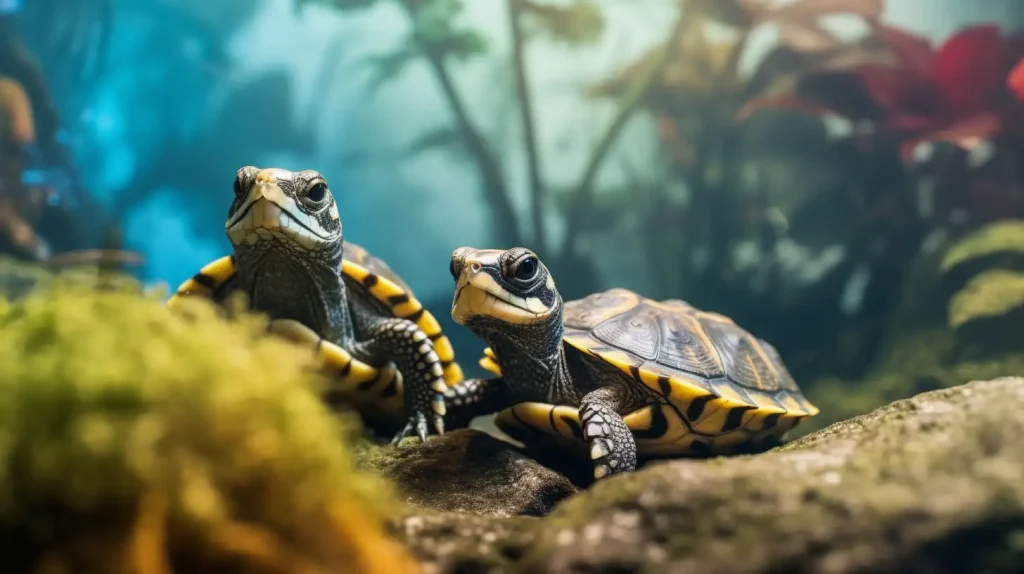
The Nutritional Value of Different Foods
When curating a diet for your terrapin, understanding the nutritional value of different foods is pivotal. This understanding enables you to provide a balanced and nourishing diet to your pet, enhancing its health and longevity.
Protein-Rich Foods
Terrapins are inherently omnivorous and their dietary plan includes a variety of foods. Foods such as bloodworms, earthworms, and small raw fish offer substantial protein necessary for tissue growth and repair. For terrapins, protein is an indispensable nutrient, particularly for juveniles, as it aids their growth phase. Store-bought terrapin food, as well as dog or cat pellets, also provide a decent protein source, accompanied by an array of other essential nutrients.
Vegetables and Aquatic Plants
While it might seem that terrapins favour animal matter, about 20-30% of their diet should include green leafy vegetables or aquatic plants. These sources offer crucial vitamins and minerals that are essential for overall health. For instance, vegetables like carrots provide beta-carotene, a form of Vitamin A, which is necessary for good vision and a healthy immune system. Aquatic plants also offer fibre that aids digestion and promotes bowel regularity in terrapins.
Fruits
Fruits such as apple, strawberries, and pear are not only loved by terrapins, but they also bring a splash of vitamins and antioxidants to their diet. Antioxidants combat harmful free radicals in the body, reducing the risk of disease.
Vitamin and Mineral Supplements
To ensure that your terrapin is receiving a well-rounded diet, supplementing with vitamins and mineral powders can be beneficial. These supplements ensure your terrapin receives all the necessary micronutrients which might be missing from their core diet.
Here’s a detailed table of foods that a terrapin can and cannot eat:
| Food Category | Can Eat (Examples) | Cannot Eat (Examples) |
|---|---|---|
| Meat/Protein | Raw small fish (trout, mackerel, sardines), prawns, bloodworms, earthworms | Cooked meat, processed meats |
| Commercial Pet Food | Terrapin-specific pellets or food | Dog or cat food not designed for terrapins |
| Fruits | Apples, strawberries, pears | Citrus fruits (oranges, lemons, grapefruit), avocado |
| Vegetables | Leafy greens (kale, spinach), carrots | Onions, garlic, mushrooms |
| Aquatic Plants | Duckweed, water lettuce | Any plant treated with pesticides or fertilizers |
| Insects | Earthworms, bloodworms, mealworms | Insects treated with pesticides or fertilizers |
| Dairy | None | Milk, cheese, yogurt |
| Grains | None | Bread, pasta, rice |
| Human Foods | Raw meats, some fruits and vegetables | Processed foods, sweets, salty foods, spicy foods |
| Supplements | Vitamin and mineral powders designed for terrapins | Human dietary supplements |
Please remember, the best way to provide a balanced diet to your terrapin is to offer a variety of foods. Ensure you feed them a good mix of animal protein, vegetables, and fruits. Monitor your terrapin for any adverse reactions when introducing new food items. In case of uncertainty, always consult with a vet or a terrapin expert.
Differences in Diet Based on Terrapin Species
Terrapins, being as diverse and varied as they are, possess a range of dietary preferences that are influenced by their species, natural habitat, and age. To meet the individual nutritional needs of different terrapin species, a keen understanding of their distinctive dietary requirements is vital.
North American Terrapins
Let’s start with a popular choice for pet enthusiasts: the North American terrapins, particularly the Red-Eared Slider and the Painted Terrapin. These species are primarily omnivorous and have a balanced diet of both plant and animal matter. Young ones lean more toward carnivory, often feasting on small aquatic animals like snails, worms, and insects, while adults develop a partiality for vegetation, such as aquatic plants and leafy vegetables.
Diamondback Terrapins
On the other hand, Diamondback Terrapins, another species native to the brackish waters along the U.S. east coast, have a dietary preference leaning heavily towards meat. They particularly favor mollusks, including clams and snails, thanks to their strong, crushing jaws. While they can eat some plant matter, it forms a much smaller part of their diet.
European Pond Terrapins
If we venture across the Atlantic to Europe, European Pond Terrapins exhibit dietary patterns somewhat similar to North American Terrapins but have a pronounced preference for live prey, particularly during their juvenile stages. This can include insects, small fish, and even amphibians. As they mature, they’ll diversify their diet with a mix of aquatic vegetation.
A nuanced understanding of the dietary needs of your specific terrapin species ensures your shelled companion remains healthy and thriving. Tailoring their diet to their species and natural preferences also contributes to a stimulating environment that mimics their natural habitat – a cornerstone for any pet’s wellbeing.
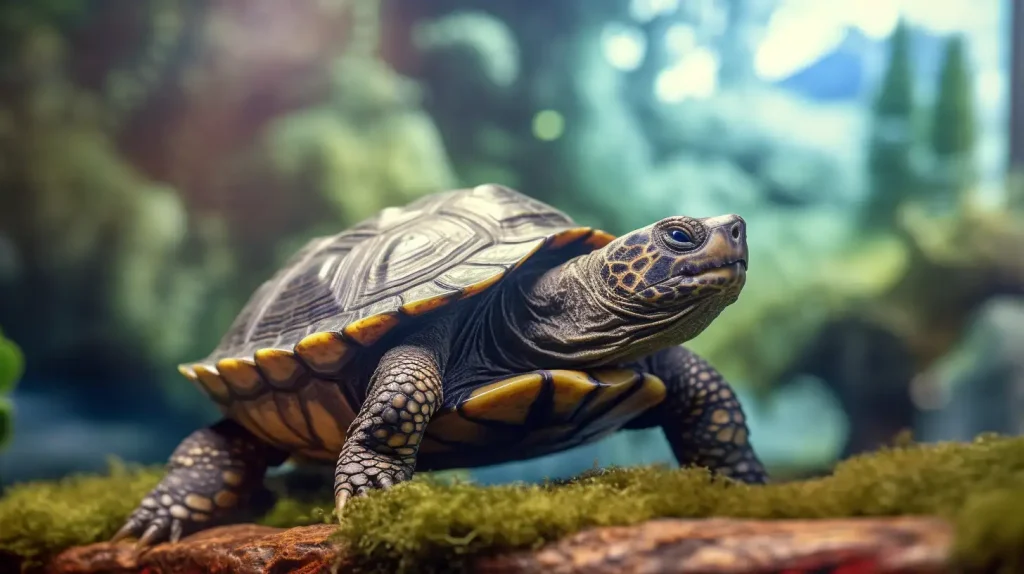
What Human Food Can Terrapins Eat?
In addition to commercial terrapin food, you might be surprised to find out that there are some human foods you can also offer up. Small chunks of raw meat such as chicken, beef, pork, and fish are an option. Indeed, terrapin’s love fish such as trout as well as prawns, but they particularly love oily fish like mackerel, sardines, and tuna. If you are providing raw meat for the terrapin, do make sure that it is cut into small pieces to make it easier to eat.
Terrapins eat in the water and like to tear pieces of food off with their teeth and claws. Whatever falls to the bottom of the tank is likely to stay there and be wasted. As you can imagine, this can quickly lead to the tank and water becoming dirty. Therefore, the smaller the pieces of food you offer, the more likely the terrapin is to eat it all.
In addition to meat, terrapins also like to eat plant foods such as fruit and vegetables. You can chop up things like apple, strawberries, pear, carrot, and green leafy vegetables. Again, very small chunks are required here.
Food Allergies and Intolerances in Terrapins
Terrapins, like many animals, can exhibit signs of food allergies or intolerances, although it’s far less common than in humans. One essential aspect to remember is that their digestion system differs significantly from ours, and some foods we find harmless can actually pose risks to them.
Identifying Potential Allergens
You may notice that after feeding your terrapin certain foods, it seems unwell or behaves unusually. This can include symptoms like sluggishness, refusal to eat, or changes in skin coloration. An intolerance could also manifest as digestive upset, such as diarrhea or constipation. If you notice these signs, it’s a good idea to reconsider the recently introduced foods in your terrapin’s diet.
Common Problematic Foods
While it’s rare, some terrapins have been known to have a negative response to certain proteins, especially if fed in excess. Raw meats, particularly red meat and pork, can sometimes be problematic when fed frequently. Certain types of fish high in thiaminase, such as goldfish and minnows, can lead to vitamin B1 deficiency if fed too often. Dairy products are also a definite no-no as terrapins are lactose intolerant.
Safeguarding Your Terrapin’s Health
Always introduce new foods gradually and monitor your terrapin’s reaction to it. If your pet shows signs of a food intolerance, stop feeding the suspected item immediately and consult with a vet if symptoms persist. A varied diet, ensuring all nutritional needs are met, is the best approach to keep your terrapin healthy and prevent any potential intolerances.
Remember, balance and moderation are key to feeding your terrapin. An excess of any single food source could lead to health problems down the line. Therefore, it’s always a good idea to keep track of what your terrapin eats and how it responds, so you can ensure a happy, healthy pet.
Special Dietary Needs of Baby/Juvenile Terrapins
When we’re speaking about the dietary needs of terrapins, it’s essential to understand that those needs change significantly as they grow. Baby and juvenile terrapins, in particular, have distinct nutritional requirements that are instrumental to their development and overall health.
Nutritional Requirements
Firstly, baby terrapins are primarily carnivorous, unlike adults that are more omnivorous. As such, their diet should consist largely of animal matter, specifically high-protein foods. They thrive on small, whole prey items such as earthworms, bloodworms, mealworms, and small fish. These nutrient-rich foods are crucial for their rapid growth and shell development during this early stage.
Frequency of Feeding
Secondly, the frequency of feeding changes as they grow. Baby terrapins require daily feeding given their high metabolic rate and the rapid growth they experience. As they mature and their growth slows, the feeding frequency can be gradually reduced.
Transition to Adult Diet
Thirdly, as they transition from being juveniles to adults, their diet should slowly become more omnivorous, incorporating more plant matter. Starting from around one year old, you can start introducing small amounts of aquatic plants and leafy greens, gradually increasing these over time. This shift helps prepare them for their adult diet and promotes healthy digestion and nutrient absorption.
Remember, these dietary adjustments should be gradual and monitored closely to ensure your terrapin is adapting well to the changes. The journey from baby to adult terrapin might seem a little complicated, but with careful attention and appropriate dietary changes, you can ensure your terrapin transitions smoothly and healthily through these important life stages.
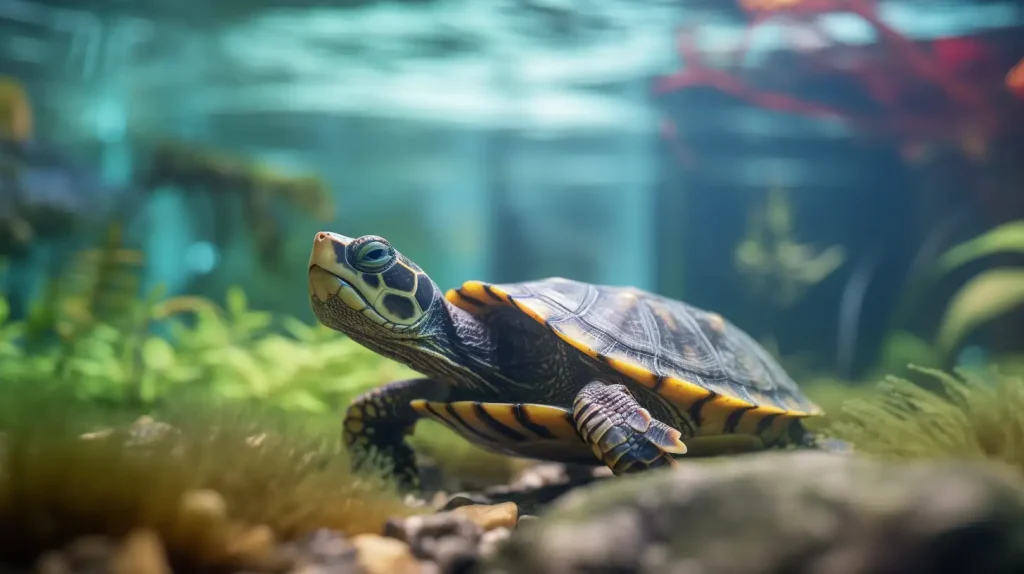
How Many Times a Day Should I Feed My Terrapin?
Terrapins do not usually require feeding every day. In fact, only juveniles should be fed daily. Adult terrapins only need feeding every two or three days.
When providing food, offer no more than the terrapin can eat in a thirty-to-forty-minute period (initially, a bit of trial and error is needed).
When providing food, make sure to use long-handled tweezers to place the food in the water or just drop it in from above. Do not place your hand into the water as terrapins can be quite aggressive feeders. Large terrapins could accidentally nip your finger in their bid to get to their food quickly.
As terrapins are messy eaters, some keepers prefer to feed them in a separate tank in a bid to keep the main tank clean. However, it is important to note that regular handling of the terrapin could cause undue stress and may not be appropriate.
If you are handling the terrapin and moving it to a separate feeding tank, it is important that you practice good hand hygiene after. You must wash your hands thoroughly in soapy water as there is a risk that, like all reptiles , your terrapin is carrying salmonella. While unlikely to be dangerous to the terrapin itself, it can be transmitted to you.
, your terrapin is carrying salmonella. While unlikely to be dangerous to the terrapin itself, it can be transmitted to you.
Terrapin Feeding Schedule
It’s not just what you feed your terrapin that’s important, but also when and how often. The feeding schedule for terrapins does vary somewhat depending on their age, size, and species, so it’s key to adjust their meals as they grow.
Juvenile Terrapins
Younger terrapins, often classified as those under one year of age, need a regular and nutritious diet to support their rapid growth. They typically benefit from being fed daily. This is a crucial stage in their life where a balanced diet consisting of both plant matter and animal protein helps ensure proper development. Feeding should ideally take place during the morning hours, as this aligns with their active period in the wild.
Adult Terrapins
As terrapins mature, their metabolic rate slows down, thus reducing the frequency of feedings required. Adult terrapins are usually fed every two to three days. Morning time remains an optimal feeding time due to their diurnal nature. That said, adjusting feeding times to early evening can work as well, especially if this suits your personal schedule better.
Adjusting the Feeding Schedule
It’s crucial to remember that as terrapins age, their nutritional needs change. As your pet terrapin grows, the proportion of plant matter in their diet should gradually increase, with a relative decrease in animal protein. This helps prevent issues like obesity and shell deformities common in overfed terrapins.
Also, don’t forget to consider the quality of the food you’re providing. A terrapin’s appetite can be an excellent indicator of its health and happiness. If you notice any sudden changes in your terrapin’s eating habits, it could be a sign of illness or stress, and seeking advice from a professional would be recommended.
Weight Management and Overfeeding
As you embark on the exciting journey of caring for your terrapin, it’s important to understand that, much like other pets, maintaining a balanced diet and preventing overfeeding are crucial to your terrapin’s health.
The Risks of Overfeeding
Overfeeding a terrapin can lead to numerous health issues, including obesity, which can decrease its lifespan and affect its overall quality of life. Obese terrapins may face mobility issues and could become prone to various diseases such as shell deformities, heart diseases, and liver problems. Overfeeding can also lead to poor water quality due to an excess of uneaten food, which can consequently harm your terrapin’s health.
Recognizing Overfeeding
Recognizing overfeeding can be tricky, especially for new terrapin owners. As a rule of thumb, a healthy terrapin’s shell should be smooth, without any noticeable bulges. If the shell appears overly rounded or the terrapin seems unable to retract its head and legs fully into its shell, this could indicate overfeeding. Similarly, if your terrapin’s skin seems excessively folded or bunched when it retracts its head or limbs, it may be overweight.
Maintaining Terrapin’s Weight
Maintaining a healthy weight in your terrapin largely involves providing a balanced diet and regular feeding schedule. Terrapins thrive on a diet rich in animal proteins and aquatic plants or leafy vegetables. Adult terrapins should ideally be fed once every two to three days, and remember to offer only what they can consume within a thirty to forty-minute period.
Another crucial factor in weight management is ensuring your terrapin gets sufficient exercise. A terrapin’s enclosure should be spacious enough to allow for swimming and exploration, as this helps them burn off energy and maintain a healthy weight. Regularly changing the layout of their tank can also encourage more activity, as terrapins are often spurred to explore changes in their environment.
Transitioning Diets
Just like us humans, a terrapin’s dietary needs change as they grow. Understanding how to navigate this transition is crucial for your pet’s health. However, don’t fret – it may sound complex, but with a little bit of knowledge, it’s simpler than it seems.
From Juvenile to Adult
Young terrapins, or hatchlings, require a diet that’s a bit different from that of their adult counterparts. They need a higher proportion of protein to support their rapid growth. In general, a hatchling’s diet should comprise about 80-90% animal-based foods, like small fish, bloodworms, or specially formulated terrapin pellets.
As your terrapin matures into an adult, which typically happens around the age of 2-4 years, you should gradually adjust their diet to incorporate a higher proportion of plant-based foods. Adult terrapins thrive on a diet that’s roughly 70-80% animal-based and 20-30% plant-based. So, you may start adding more leafy greens and vegetables, such as kale or carrots, to their meals.
Tips for Dietary Transition
The key to a successful dietary transition is gradual change. If you try to switch your terrapin’s diet overnight, they might reject the new food, causing undue stress. Instead, start by introducing small amounts of the new food to their regular meals. Gradually increase the proportion over a few weeks until you reach the desired ratio.
It’s also important to monitor your terrapin’s response throughout the transition. If they’re not eating the new food or showing signs of distress, it’s a good idea to consult with a vet or a reptile specialist.
Necessary Diet Changes
Sometimes, it might be necessary to change your terrapin’s diet due to health reasons. For instance, if your terrapin develops a vitamin deficiency, you might need to adjust their diet or add dietary supplements. Again, any changes should be gradual and under the guidance of a veterinary professional.
Remember, a varied and balanced diet is essential to your terrapin’s health. So even after you’ve transitioned to an adult diet, make sure to continue providing a range of foods to ensure your terrapin gets all the nutrients they need. After all, variety is the spice of life, and your terrapin would surely agree!
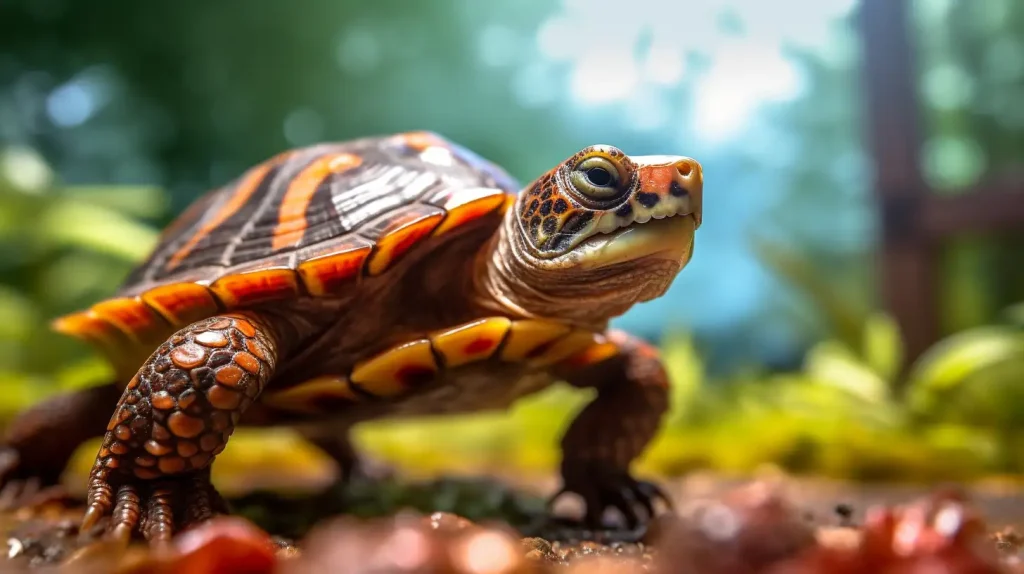
Do Terrapins Drink Water?
A question often asked by those interested in keeping terrapins is whether or not they need to provide separate drinking water for the creature. While terrapins do drink water, it is not necessary to provide a separate dish of drinking water, as long as they have an area of water in which they can swim, soak, and drink.
Why Is My Terrapin Not Eating?
It is natural to be concerned if your terrapin is not eating as this could be a sign that something is not quite right. The first thing to do is try to determine why it is not eating as this may not always be caused by an illness.
In fact, terrapins can stop eating if they become too cold. Check the temperature of the water, which should be around 78F. Your terrapin’s basking area should be between 80F and 85F.
It is also important that the terrapin has adequate lighting. Both UVA and UVB lighting is required, and it is important to establish a day/night schedule. The optimum lighting schedule is twelve hours of light, followed by twelve hours of darkness. Less than twelve hours of light per day could result in a loss of appetite.
Of course, there is the chance that your terrapin is ill, so this is something you need to check. White patchy discoloration on the terrapin’s shell could indicate a deficiency in Vitamin A, which could in turn cause a respiratory infection. If the terrapin appears to also be struggling to breathe, has swollen eyes, is lethargic, and has what looks like a runny nose, contact an experienced exotic vet for advice.
Signs of a Healthy Diet
When it comes to ensuring the well-being of your terrapin, diet plays an integral role. So, what signs should you look for to ascertain if your terrapin’s diet is optimal? Here are some key points to consider.
Bright and Clear Eyes
One of the first signs of a healthy diet in terrapins is their eyes. A terrapin that is getting the right nutrition should have bright and clear eyes. Conversely, if your terrapin’s eyes are swollen, cloudy, or closed often, this could be a sign of a nutritional deficiency or another health problem.
Healthy Shell
The shell of a terrapin should be solid and smooth, without any soft spots or irregularities. If you notice any discoloration, white patches, or if the shell feels soft to the touch, this could indicate a problem such as a lack of necessary vitamins or minerals in the diet. It’s worth noting that shell health can also be affected by the terrapin’s environment, including water quality and temperature.
Active Behavior
A terrapin on a balanced diet should exhibit active behavior. They should be eager to explore their surroundings and show interest in their food. Sluggishness or lethargy might indicate an inadequate diet or a possible health issue.
Consistent Eating Habits
Healthy terrapins will have consistent eating habits. They should eagerly anticipate their meals and eat the food provided promptly. If your terrapin is refusing food, eating less than usual, or has an irregular appetite, it could be a sign of a dietary issue or an underlying health problem.
Regular and Healthy Excretions
Lastly, check your terrapin’s excretions. They should be regular and consistent. Changes in the color, consistency, or frequency might be a sign of a dietary imbalance or potential illness.
Remember, each terrapin is unique and what’s normal for one might not be for another. So, it’s essential to get to know your own pet’s habits and behaviors. It’s always a good idea to consult with a vet if you notice any changes that concern you. They can help you to decipher if these changes are related to diet or if there’s another underlying issue.
How Long Can Terrapins Go Without Food?
As cold-blooded creatures, terrapins in the wild will have periods where they slow their metabolism down in response to a decrease in temperature. They will generally try to hide under mud and will restrict their movement and stop eating. This is known as hibernation and can continue for a period of between one and three months.
In captivity, the temperature of the water can be controlled and kept constant to prevent hibernation.
What Do Terrapins Eat – Conclusion
In conclusion, knowing what to feed your terrapin, when, and how much is key to ensuring its health and wellbeing. By providing a varied and balanced diet rich in animal matter, supplemented with vitamins and minerals as necessary, you can help your pet thrive. It’s also essential to monitor for signs of illness and identify any problematic foods that may cause adverse reactions. Additionally, understanding the dietary needs of baby terrapins and managing the transition to an omnivorous diet as they grow is crucial. By following these guidelines and providing a suitable environment with enough space for exercise, you can help your terrapin stay healthy and happy throughout its life.
Key Takeaway
- Terrapins are omnivorous, with animal matter should represent 70-80% of their diet, and the remaining 20-30% should be made up of aquatic plants or green leafy vegetables.
- Food sources for terrapins can include live foods such as fish and insects, as well as specific terrapin food from a pet store.
- When feeding your terrapin, it is essential to provide small food pieces and keep the tank clean.
- A gradual dietary transition should be followed when introducing new foods to a terrapin’s diet.
- Consistent eating habits, interest in food and exploring surroundings, as well as healthy excretions are signs of a healthy terrapin.
FAQs
Q: What kind of diet do terrapins have?
A: Terrapins are omnivores, meaning they eat both plant and animal matter. In the wild, their diet consists mostly of live foods such as fish and insects, although they also eat some aquatic plants.
Q: How much of a terrapin’s diet should consist of animal matter?
A: The Royal Veterinary College in the UK recommends that 70-80% of a terrapin’s diet should consist of animal matter, with the remaining 20-30% made up of aquatic plants or green leafy vegetables.
Q: Can I feed my terrapin commercial pet food?
A: Yes, you can feed your terrapin specially created terrapin food available in pet stores or online. These foods are balanced to ensure the health and wellbeing of your terrapin.
Q: What kind of human food can terrapins eat?
A: Small chunks of raw meat such as chicken, beef, pork, and fish are suitable for terrapins. They can also eat plant foods like apples, strawberries, carrots, and green leafy vegetables.
Q: How often should I feed my terrapin?
A: Adult terrapins only need feeding every two or three days. Juvenile terrapins, however, should be fed daily.
Q: Do terrapins drink water?
A: Yes, terrapins drink water, but it is not necessary to provide a separate dish of drinking water. Terrapins typically meet their hydration needs from the water in their enclosure where they swim and soak.
Q: What should I do if my terrapin is not eating?
A: If your terrapin is not eating, it could be due to several reasons. Check the temperature of their enclosure, their lighting schedule, and look out for signs of illness. If the problem persists, consult with an exotic pet veterinarian.
Q: Can terrapins eat dairy products?
A: Terrapins cannot digest dairy products, and these should be avoided in their diet.
Q: Can I feed my terrapin fruits?
A: Yes, terrapins can eat fruits such as apples, pears, and strawberries. However, fruits should make up a small portion of their diet and be given as a treat, not a staple.
Q: Can terrapins eat bread?
A: Bread is not recommended for terrapins. It has little nutritional value for them and can cause digestive issues.
Q: Can I feed my terrapin cooked food?
A: It’s best to offer raw foods to your terrapin. Cooking can diminish the nutritional value of food and could also make it more difficult for your terrapin to eat.
Q: Can terrapins eat insects?
A: Yes, terrapins can eat insects such as worms, but ensure they are safe and free from pesticides.
Q: Can I feed my terrapin vegetables?
A: Yes, terrapins can eat a variety of vegetables including green leafy vegetables like kale and spinach. Vegetables should be cut into small pieces to make them easier to eat.
Q: Do terrapins eat plants in their enclosure?
A: Terrapins might nibble on any aquatic plants in their enclosure. Therefore, ensure that any plants present are safe for consumption.
COPYRIGHT NOTICE
Please be advised that all images, designs, and creative content on this page are the exclusive property of JustExoticPets.com and are protected under international copyright laws. The images may not be reproduced, copied, transmitted or manipulated without the written permission of JustExoticPets.com.
and are protected under international copyright laws. The images may not be reproduced, copied, transmitted or manipulated without the written permission of JustExoticPets.com.
Unauthorized use, distribution, display, or creation of derivative works of any images contained on this site, is strictly prohibited and can lead to legal penalties. We actively monitor for, and enforce, our copyright interests.
If you wish to use any of our images, kindly contact us to seek permission. Respect of copyright is not merely a legal requirement but also an acknowledgement and support of the hard work and creativity that goes into producing them.
Thank you for your understanding and cooperation.
© 2023, JustExoticPets.com. All Rights Reserved.

